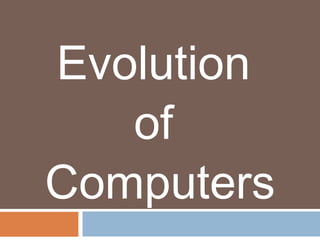
Evolu
- 1. Evolution of Computers
- 2. The Abacus It was the earliest calculating machine probably originated in China about 3,000 years ago. In China it is also known as Swan Pan.
- 3. It is consists of a rectangular wooden frame with horizontal rods. It is consist of several columns, farthest to the right represent ‘ones’, the next one ‘tens the hundreds and so on.’
- 4. John Napier A mathematician, developed a device having a set of rods made of bones. In 1964, John Napier introduced Logarithms.
- 5. Blaise Pascal He was a French Mathematician born on 19th June 1623 at Clermont- Ferrand. He was only 19 years old, when he invented a calculating machine called Pascaline.
- 6. Analog Computer These are fundamentally different in principle from the modern digital computers. It is use in simple devices, even they are mechanically complicated.
- 7. Joseph- Marie Jacquard (1752-1834) He introduced a new weaving loom in 1805. The Jacquards Weaving System using punched card attracted many scientist.
- 8. Charles Babbage (1792-1871) He was inspired by the punched Card to idea, developed an idea of using punched cards to input data. He continued his efforts and put forward an idea of a machine that can do 60 calculations per second. The Analytical Engine stamped the foundation for modern computing.
- 9. The First Programmer Ada Augusta King (1815-1852) The daughter of Lord Byron, was the personal assistant of Charles Babbage.
- 10. She suggested binary data storage and wrote the first computer program for the Analytical Engine. The ADA software was named
- 11. George Boole (1815-1864) He was self taught English Mathematician. His theory of Boolean logic became fundamental to the design of computer circuitry.
- 12. Dr. Herman Hollerith He developed punched card system for storing and retrieving data. He also built the tabulating machine to read the cards and processing data.
- 13. He started Tabulated Machines Companies in 1896. In 1911 , this company became the Computing Tabulating Recording Company and now the International Business machines, simply IBM.
- 14. Digital Era Claude Shannon He suggested 1’s and 0’s of binary systems can be considered ‘ON’ and OFF position of the flow of current.
- 15. Dr. John Vincent Atanasoff He built the first electronic computer named Atanasoff Berry Computer.
- 16. J. Presper Eckert and John W illiam Mauchy They developed general purpose computer, Electronic Numerical Integrator and Calculator (ENIAC). This computer has 1800 valves consuming 100 kilowatts of power and weighed several tons.
- 17. John Von Neuman He introduced an idea of entering the program of instructions into the machines for its procedures as the numerical data is entered.
- 18. Admiral Grace Hopper She developed this idea and it was designed and built by Mauchy and Eckert. The first commercial electronic digital computer capable of using stored programs was called Universal Automatic Calculator (UNIVAC).
- 19. Transistors In 1947, computers entered a second generation by the introduction of transistors. It was developed by the American physicist William Shockley.